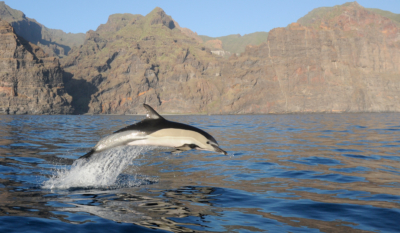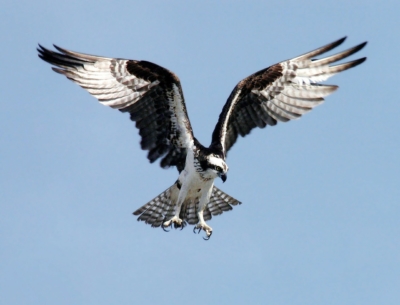Common dolphin (Delphinus delphis)
The common dolphin is present in most of the world’s seas. They are easily identifiable by the special yellowish colouration on their flanks. They are more likely to be seen in winter. Weight: 80-130 kg. Size: up to 2,5 metres.

Fin whale (Balaenoptera physalus)
The most distinctive feature of the fin whale is its colouring. The body dorsally and laterally is black or dark grey-brown, gradually turning white towards the ventral region. However, the colour on the head is asymmetrical. The right side of the face is light grey and the jaw white, as is the rest of the colouring of the throat and belly. The left half of the face is darker, with the jaw and part of the throat dark grey. There is a series of transverse discolouration on the dorsum behind the head, the most apparent being an inverted V-shaped discolouration, most marked on the right side.
Loggerhead sea turtle (Caretta caretta)
It is an oceanic turtle spread all over the world. It is a marine reptile, belonging to the family Cheloniidae. The average loggerhead is about 90 cm (35 in) long when fully grown, although larger specimens have been found up to 280 cm (110 in). The adult loggerhead sea turtle weighs approximately 135 kg (298 lb), with the largest specimens weighing over 450 kg (1,000 lb). The skin varies from yellow to brown, and the carapace is typically reddish brown. No external sex differences are seen until the turtle becomes an adult, the most obvious difference being that adult males have thicker tails and shorter plastrons (undershells) than females.
Green turtle (Chelonia mydas)
Also known as black (sea) turtle or Pacific green turtle, it is a large sea turtle of the family Cheloniidae. It is the only species in the genus Chelonia. Its range extends across tropical and subtropical seas worldwide, with two distinct populations in the Atlantic and Pacific Oceans, but it is also found in the Indian Ocean. The common name comes from the generally green blubber found under their shells[cita requerida] the shells of these turtles are olive to black in colour.
Hawksbill sea turtle (Eretmochelys imbricata)
It is a critically endangered sea turtle belonging to the family Cheloniidae. It is the only extant species in the genus Eretmochelys. The species has a worldwide distribution, with Atlantic and Indo-Pacific subspecies: the appearance of the hawksbill turtle is similar to that of other sea turtles. In general, it has a flattened body shape, a protective shell and flipper-like limbs, adapted for swimming in the open ocean. E. imbricata is easily distinguished from other sea turtles by its sharp, curved beak with a prominent tomium and the serrated appearance of its carapace margins. Hawksbill shells change colour slightly, depending on water temperature. While this turtle lives part of its life in the open ocean, it spends more time in shallow lagoons and coral reefs.
Leatherback turtles (Dermochelys coriacea)
Sometimes called the leatherback or simply luth, it is the largest of all living turtles and is the fourth most modern reptile behind three crocodiles. It is the only living species of the genus Dermochelys and family Dermochelyidae. It can be easily distinguished from other modern sea turtles by its lack of a bony shell, hence its name. Instead, its shell is covered with skin and fatty flesh. Dermochelys is the only extant genus of the family Dermochelyidae.
Little Shearwater (Puffinus assimilis)
A small bird of the petrel family (Procellariidae). It is sometimes called the southern shearwater, to distinguish it from the northern shearwater (Puffinus baroli), with which it was formerly the same species.
European storm petrel (Hydrobates pelagicus)
A species of procellariform bird of the family Hydrobatidae native to the Atlantic and Mediterranean. It is the only species of the genus Hydrobates. It is a pelagic bird the size of a sparrow, with dark plumage, except for some white markings on the tail and under the wings. It feeds on small fish, zooplankton, crustaceans, squid, jellyfish and carrion. Despite its size, it is a long-lived bird (like two other members of its family), with an average lifespan of 11 years, but it can live up to 33 years.
Atlantic shearwater or Canary shearwater (Calonectris borealis)
A species of procellariiform bird of the family Procellariidae native to the Atlantic and its vicinity. It was formerly considered a subspecies of the Cory’s shearwater (Calonectris diomedea). The genus name Calonectris is derived from the classical Greek kalos, “good” and nectris, “swimmer”, while the specific name borealis is from the Latin for “north”.3 It is a seabird that spends most of the year offshore and breeds on the northern islands of Macaronesia. It feeds mainly on squid and fish, which it catches by diving to depths of up to 15 metres. It is a large shearwater, with brownish upperparts, as its name suggests, while its underparts are white, except for the edges of its long wings, which are brownish.
Osprey (Pandion haliaetus)
Also known as halieto, guincho or fish hawk, it is a species of accipitriform bird of the family Pandionidae. It is a medium-sized bird of prey, occurring on all continents except Antarctica, although in South America it is only a non-nesting migrant. Some classifications place it as the sole member of the genus Pandion, while others consider a second species within this genus, Pandion cristatus.


